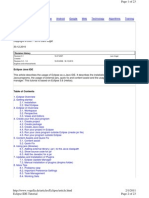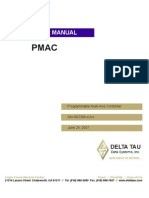Eclipse 01 Intro
Eclipse 01 Intro
Uploaded by
akashbabudwarikapur97Copyright:
Available Formats
Eclipse 01 Intro
Eclipse 01 Intro
Uploaded by
akashbabudwarikapur97Copyright
Available Formats
Share this document
Did you find this document useful?
Is this content inappropriate?
Copyright:
Available Formats
Eclipse 01 Intro
Eclipse 01 Intro
Uploaded by
akashbabudwarikapur97Copyright:
Available Formats
Creating a Java project in Eclipse
When you start the Eclipse application, you see a window that looks like this. You may not see the Package Ex-
plorer pane initially; it may look like this. You can make that pane visible using a menu item from the top horizontal
menu bar. This is where it is on the mac; on other machines it’s in a slightly different place but easily seen. We use
menu item Window -> Show View -> Package Explorer.
Now, we have:
1. The Package Explorer pane will contain Java projects.
2. The pane in the middle will later contain Java files that you are editing.
3. Some other parts, which we will look at later.
Creating a Java project
We show you how to create a Java project. First, use menu item File -> new -> Java Project.
In the window that opens, type a project name. Use the default location. Eclipse will store all projects in the de-
fault location unless you tell it differently. Note where it is! Use execution environment JavaSE-1.8. We suggest
using separate folders for sources and class files —more on this later. Click Finish.
You see the project in the Package Explorer Pane. Click the horizontal arrow that is before the project name to
see that the project contains a source (src) directory and a library.
Adding a Java class to the project
Let’s add a Java class to the project. With the project selected, use menu item File -> New -> Class —or hover
your mouse over the white c in the green circle until “New Java Class” appears and then click the mouse. The win-
dow opens for information about a new Java class.
The project will be put in directory firstDemo/src. Make the Package field empty. This is important! Give the
class a name: Greetings. Click the box to create method main. Then click Finish.
The class has been created and placed in the so-called “default package”, and the middle pane contains the gen-
erated class. The Outline pane contains a list of components of class Greetings. If there are several of them, clicking
one will select that component in the editing pane. This is an easy way to get to a particular line in the editing pane.
Make method main do something
Let’s put a comment in to say what method main will do. Now, we can write a statement to do what the com-
ment says. The statement that will print a String x to the console pane is
System.out.println(x);
We replace x by the string literal that we want to print. Before starting this video, I placed in my clipboard a greeting
in the 5 most popular languages: Chinese, Spanish, English, Hindi, and Arabic. So let me paste that line in here, sur-
rounded by double quotes. After the video, we’ll show you more about the greetings.
By the way, I change the sizes of the various panes by placing the mouse between panes, pressing the mouse but-
ton, and dragging.
Executing (running) the Java application
Because class Greeting has a static procedure main, it is an application and can be executed, or run. Running this
class consists of calling method main. We can run it simply by using menu item Run -> Run or by clicking the white
arrow in the green circle. Let’s click the arrow.
We have not saved the file yet, so a window pops up, asking us whether it should be saved. Let’s check the box
that says to always save resources before running a program. Now, we will never have to see this window again.
Now, click the OK button. That window disappears, the program is run, and the results of execution are shown in
the Console pane.
We discuss main’s parameter later
Method main has a parameter, of type String[]. You do not yet know about arrays in Java, and you don’t know
how to give an argument to method main. We’ll talk about this much later.
ÓDavid Gries, 2018
You might also like
- Acer Diagnostic Suite Toolkit: User GuideDocument57 pagesAcer Diagnostic Suite Toolkit: User GuideKiran M50% (2)
- Javascript: Javascript Programming For Absolute Beginners: Ultimate Guide To Javascript Coding, Javascript Programs And Javascript LanguageFrom EverandJavascript: Javascript Programming For Absolute Beginners: Ultimate Guide To Javascript Coding, Javascript Programs And Javascript LanguageRating: 3.5 out of 5 stars3.5/5 (2)
- CHAMII Plus User ManualDocument60 pagesCHAMII Plus User Manualenzoln100% (1)
- Getting Started With Java and EclipseDocument14 pagesGetting Started With Java and EclipseBenneth ObilorNo ratings yet
- Lab 1Document4 pagesLab 1natthyassefaNo ratings yet
- Mit1 00S12 PS 0 PDFDocument10 pagesMit1 00S12 PS 0 PDFMohammad AliNo ratings yet
- Eclipse TutorialDocument24 pagesEclipse TutorialAbe Stefan BacasNo ratings yet
- The NetBeans SoftwareDocument84 pagesThe NetBeans SoftwareSarimSomalyNo ratings yet
- Tutorial 3Document5 pagesTutorial 3John Paul CordovaNo ratings yet
- 01 Getting Started With Eclipse (Sep 2023 Update)Document18 pages01 Getting Started With Eclipse (Sep 2023 Update)Abdul-muiz Olatunbosun OlaleyeNo ratings yet
- Eclipse Download and InstallationMIODocument31 pagesEclipse Download and InstallationMIOAndrew G. McDonaldNo ratings yet
- Intro To Eclipse MacDocument7 pagesIntro To Eclipse MacKumar BhambheyNo ratings yet
- Study Guide: Object Oriented Programming (OOP)Document9 pagesStudy Guide: Object Oriented Programming (OOP)AjNo ratings yet
- How To Check If Java Was Already Installed in Your Computer/laptopDocument13 pagesHow To Check If Java Was Already Installed in Your Computer/laptopSherlyn Miranda GarcesNo ratings yet
- Java Lab FileDocument61 pagesJava Lab FileDivyansh GuptaNo ratings yet
- CSIS 235 02 GettingStartedwithJavaProgramsUsingEclipseDocument4 pagesCSIS 235 02 GettingStartedwithJavaProgramsUsingEclipseAnthony VargheseNo ratings yet
- Final InstructionsDocument5 pagesFinal Instructionsapi-509848173No ratings yet
- Oop 03Document4 pagesOop 0322-06305No ratings yet
- Using Eclipse To Run JavaDocument9 pagesUsing Eclipse To Run JavaBenneth ObilorNo ratings yet
- Nad Installation Docs-AmitDocument79 pagesNad Installation Docs-AmitShaik Mahaboob BashaNo ratings yet
- Exercises SetupDocument1 pageExercises SetupSzabó AttilaNo ratings yet
- Eclipse Java TutorialDocument4 pagesEclipse Java TutorialShehryar AhmedNo ratings yet
- Installing The Android Development Kit: 4 Installation and Configuration of Your Development PlatformDocument5 pagesInstalling The Android Development Kit: 4 Installation and Configuration of Your Development Platformxm3powerNo ratings yet
- Microsoft Visual Basic 2010 TutorialDocument485 pagesMicrosoft Visual Basic 2010 TutorialEBookTutorials50% (2)
- Java Lab File - MergedDocument62 pagesJava Lab File - MergedDivyansh GuptaNo ratings yet
- Lab 1Document10 pagesLab 1mey chuNo ratings yet
- Eclipse TutorialDocument16 pagesEclipse Tutorialreply2sriNo ratings yet
- Start DevDocument18 pagesStart DevpmilyutinNo ratings yet
- Netbeans Ide Java Quick Start Tutorial: DocumentationDocument4 pagesNetbeans Ide Java Quick Start Tutorial: DocumentationDuban Diaz JulioNo ratings yet
- How To Write Java Program Using Integrated Development Environment (IDE) ? of 14Document13 pagesHow To Write Java Program Using Integrated Development Environment (IDE) ? of 14AestheticNo ratings yet
- Tutorial JavaYaDocument444 pagesTutorial JavaYastiwii18No ratings yet
- Getting Started - JavaProgrammingDocument13 pagesGetting Started - JavaProgrammingLovemoreSolomonNo ratings yet
- NetBeans IDE Java Quick Start TutorialDocument5 pagesNetBeans IDE Java Quick Start TutorialRisa ChanNo ratings yet
- Java Software Development Kit InstallationDocument18 pagesJava Software Development Kit InstallationmonighosNo ratings yet
- Laboratory 1: READ Carefully, Do Not Skip Lines Trying To Rush It!Document11 pagesLaboratory 1: READ Carefully, Do Not Skip Lines Trying To Rush It!Sammy Au JacksonNo ratings yet
- Android - A Beginner's Guide: Setup Eclipse and The Android SDKDocument8 pagesAndroid - A Beginner's Guide: Setup Eclipse and The Android SDKbrahmesh_smNo ratings yet
- Supplement J: Eclipse Tutorial For Introduction To Java Programming, 5E by Y. Daniel LiangDocument20 pagesSupplement J: Eclipse Tutorial For Introduction To Java Programming, 5E by Y. Daniel LiangEvert AriasNo ratings yet
- Java Lab ManualDocument58 pagesJava Lab ManualSRIHITHA YELISETTINo ratings yet
- Cpprog02 - Activity 1 (Bulos, Clarenze Ann T.)Document2 pagesCpprog02 - Activity 1 (Bulos, Clarenze Ann T.)Clarenze Ann TamayoNo ratings yet
- How To Survive The First Encounter With Tapestry. Installation Process Step by Step. (By: Djordje Popovic)Document16 pagesHow To Survive The First Encounter With Tapestry. Installation Process Step by Step. (By: Djordje Popovic)adrovicalmirNo ratings yet
- Lesson 1Document29 pagesLesson 1jlessley2006No ratings yet
- Java Media Programming Basics: How To Create A TurtleDocument6 pagesJava Media Programming Basics: How To Create A TurtleTaylor FullertonNo ratings yet
- Selenium IDE: Installation Launch The IDEDocument21 pagesSelenium IDE: Installation Launch The IDEhariniNo ratings yet
- Chapter 2Document5 pagesChapter 2api-3812977No ratings yet
- Omnet++: Ide Developers GuideDocument13 pagesOmnet++: Ide Developers GuideLeonardo Serna GuarínNo ratings yet
- Oop 02Document6 pagesOop 0222-06305No ratings yet
- Eclipse IDE Tutorial: Lars VogelDocument23 pagesEclipse IDE Tutorial: Lars VogelBabu ChaudharyNo ratings yet
- C++ With Visual BasicDocument10 pagesC++ With Visual BasicSovan PalNo ratings yet
- How To Install Eclipse Windows: 1.00/1.001/1.002 - Spring 2012Document7 pagesHow To Install Eclipse Windows: 1.00/1.001/1.002 - Spring 2012raghuwanshiram2562No ratings yet
- How To Install Eclipse and Get Started With Java ProgrammingDocument3 pagesHow To Install Eclipse and Get Started With Java Programminghophuloc81No ratings yet
- How To Install JavaDocument21 pagesHow To Install JavaDaya PhiriNo ratings yet
- Installing The Eclipse IDE For C PlusPlusDocument29 pagesInstalling The Eclipse IDE For C PlusPlusederickcNo ratings yet
- Getting Started With Japplets and The Netbeans Gui BuilderDocument7 pagesGetting Started With Japplets and The Netbeans Gui BuilderDanny FernandoNo ratings yet
- Paynes Dream TutorialsDocument46 pagesPaynes Dream TutorialsOnwe AugustineNo ratings yet
- NetbeansDocument8 pagesNetbeanschiragdj552No ratings yet
- Setting Up Java, Eclipse, and UnfoldingMapsDocument9 pagesSetting Up Java, Eclipse, and UnfoldingMapsaleksandarpmauNo ratings yet
- Visual Programming Menu: Muhammad KamranDocument16 pagesVisual Programming Menu: Muhammad KamranKamran khanNo ratings yet
- NetBeans IDE Java Quick Start TutorialDocument6 pagesNetBeans IDE Java Quick Start TutorialBalakumara VigneshwaranNo ratings yet
- Using Karel in EclipseDocument8 pagesUsing Karel in Eclipsekusha-rockNo ratings yet
- 16.410: Jump Starting With Java: by Robert Effinger and Shannon DongDocument5 pages16.410: Jump Starting With Java: by Robert Effinger and Shannon DongRajath RameshNo ratings yet
- NetBeans IDE Java Quick Start TutorialDocument6 pagesNetBeans IDE Java Quick Start TutorialManjeet PunekarNo ratings yet
- LIST D MergedDocument4 pagesLIST D Mergedakashbabudwarikapur97No ratings yet
- TIMETABLE CSE VI SEM Section-D 2023-24Document1 pageTIMETABLE CSE VI SEM Section-D 2023-24akashbabudwarikapur97No ratings yet
- 1-8 DBMS Lab File (Karan-9018)Document47 pages1-8 DBMS Lab File (Karan-9018)akashbabudwarikapur97No ratings yet
- Report Internship Raunak - Batra - 2101331520107Document17 pagesReport Internship Raunak - Batra - 2101331520107akashbabudwarikapur97No ratings yet
- Line Chart in WPFDocument9 pagesLine Chart in WPFAbhiNo ratings yet
- CSIG WS Creating Web ServicesDocument10 pagesCSIG WS Creating Web ServicesPriyanko ChatterjeeNo ratings yet
- Release NotesDocument100 pagesRelease NotesjorgecifNo ratings yet
- Chapter 09Document26 pagesChapter 09Fauzan PrasetyoNo ratings yet
- Module 3Document49 pagesModule 3Ranjita Satyanarayana YajiNo ratings yet
- The History of Networking PresentationDocument14 pagesThe History of Networking PresentationLink Worx SeoNo ratings yet
- B.tech Viii Bda Chapter 3Document21 pagesB.tech Viii Bda Chapter 3duggyNo ratings yet
- The Ultimate C - E - S4HCON2022 - SAP Certified Technology Specialist - SAP S4HANA Conversion and SAP System UpgradeDocument2 pagesThe Ultimate C - E - S4HCON2022 - SAP Certified Technology Specialist - SAP S4HANA Conversion and SAP System UpgradeKirstingNo ratings yet
- Pixel Hydro FlyerDocument2 pagesPixel Hydro Flyeromer.ali.jasseemNo ratings yet
- Ili9163C: A-Si TFT LCD Single Chip Driver 132Rgbx162 Resolution and 262K ColorDocument200 pagesIli9163C: A-Si TFT LCD Single Chip Driver 132Rgbx162 Resolution and 262K ColorCarlos Cárdenas BarbaNo ratings yet
- Python Lab ManualDocument24 pagesPython Lab ManualNaga KalyanNo ratings yet
- HCIP-Storage V5.5 Training MaterialDocument584 pagesHCIP-Storage V5.5 Training MaterialEddie MuchabaiwaNo ratings yet
- PMAC 2 User ManualDocument294 pagesPMAC 2 User ManualMukhlis MukhlisNo ratings yet
- Advance DbmsDocument47 pagesAdvance DbmsSaurabh SharmaNo ratings yet
- Dspic MicrocontrollerDocument6 pagesDspic Microcontrollerlavanyaganesh83No ratings yet
- Mod Menu Log - Com - Wb.goog - MKXDocument115 pagesMod Menu Log - Com - Wb.goog - MKXAlex Monroy QNo ratings yet
- AntlrDocument31 pagesAntlrduyen.ledynirisNo ratings yet
- CSEC Information Technology January 2017 P032Document13 pagesCSEC Information Technology January 2017 P032Jhanett RobinsonNo ratings yet
- Functions of Operating System - GATE NotesDocument9 pagesFunctions of Operating System - GATE NotesashishNo ratings yet
- How To Use GitHubDocument4 pagesHow To Use GitHubNicola Hughes50% (2)
- BROUCHURE v16Document12 pagesBROUCHURE v16ranjeet2000thakkarNo ratings yet
- Math 012/ Math 012B Numerical Methods and Analysis Matlab Activity 1.1 Operators and Numerical FunctionsDocument6 pagesMath 012/ Math 012B Numerical Methods and Analysis Matlab Activity 1.1 Operators and Numerical FunctionsroseleenNo ratings yet
- UsingGAlib PDFDocument24 pagesUsingGAlib PDFMaiNo ratings yet
- Iot Based Smart Garden Monitoring System Using Nodemcu MicrocontrollerDocument9 pagesIot Based Smart Garden Monitoring System Using Nodemcu MicrocontrollerPatel KanviNo ratings yet
- Grade 6 (Software and Hardware)Document7 pagesGrade 6 (Software and Hardware)Imali ChathurangaNo ratings yet
- Defining Maintenance Routes - Oracle Enterprise Asset ManagementDocument4 pagesDefining Maintenance Routes - Oracle Enterprise Asset ManagementPedro ViegasNo ratings yet
- Parallel Processing Quiz No 1 Fill in The BlanksDocument2 pagesParallel Processing Quiz No 1 Fill in The BlanksDEVESH RANJANNo ratings yet
- PWP Model Answer Summer 2022Document23 pagesPWP Model Answer Summer 2022Pratiksha Jadhav100% (9)





























































































